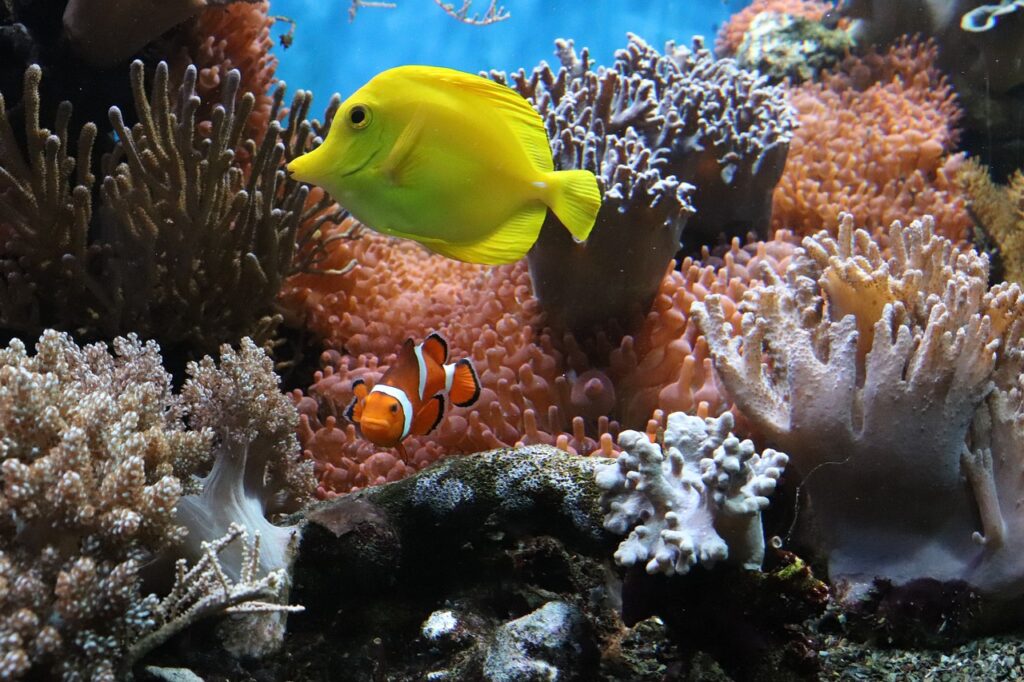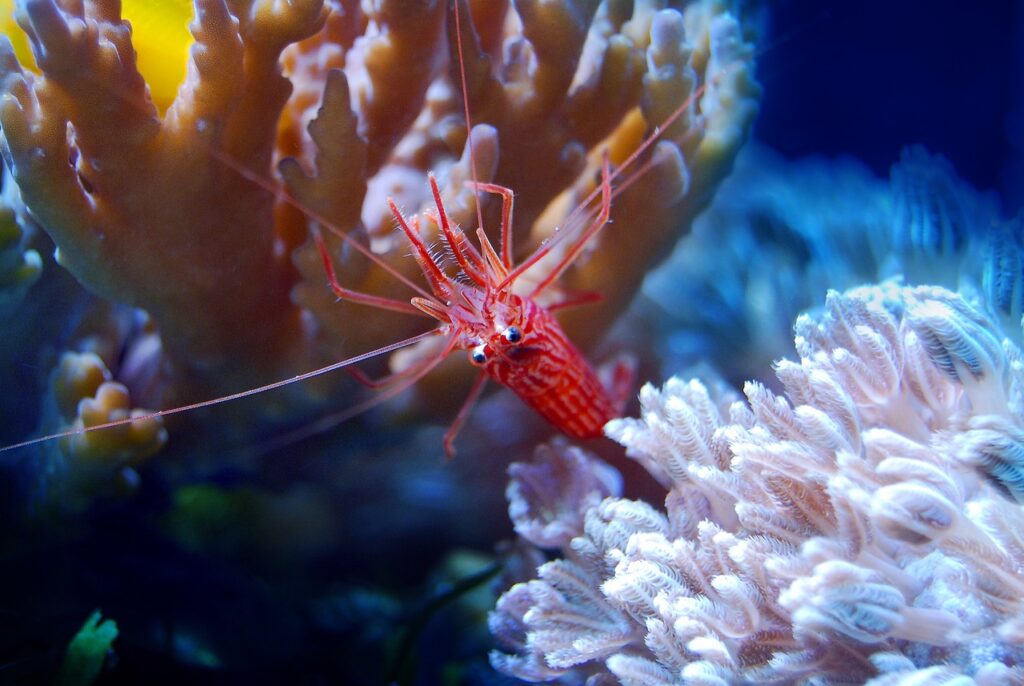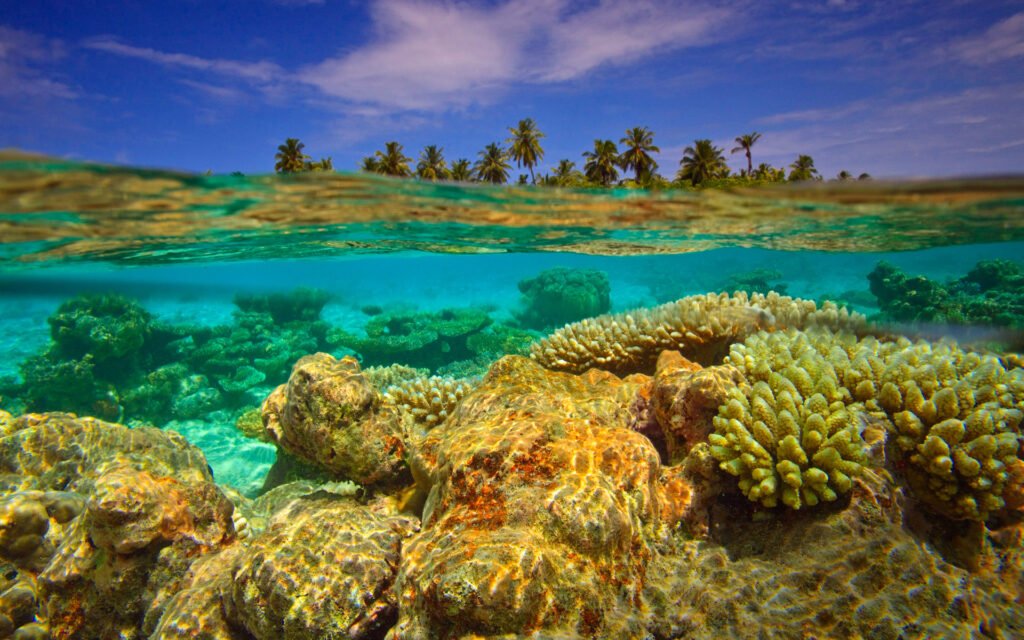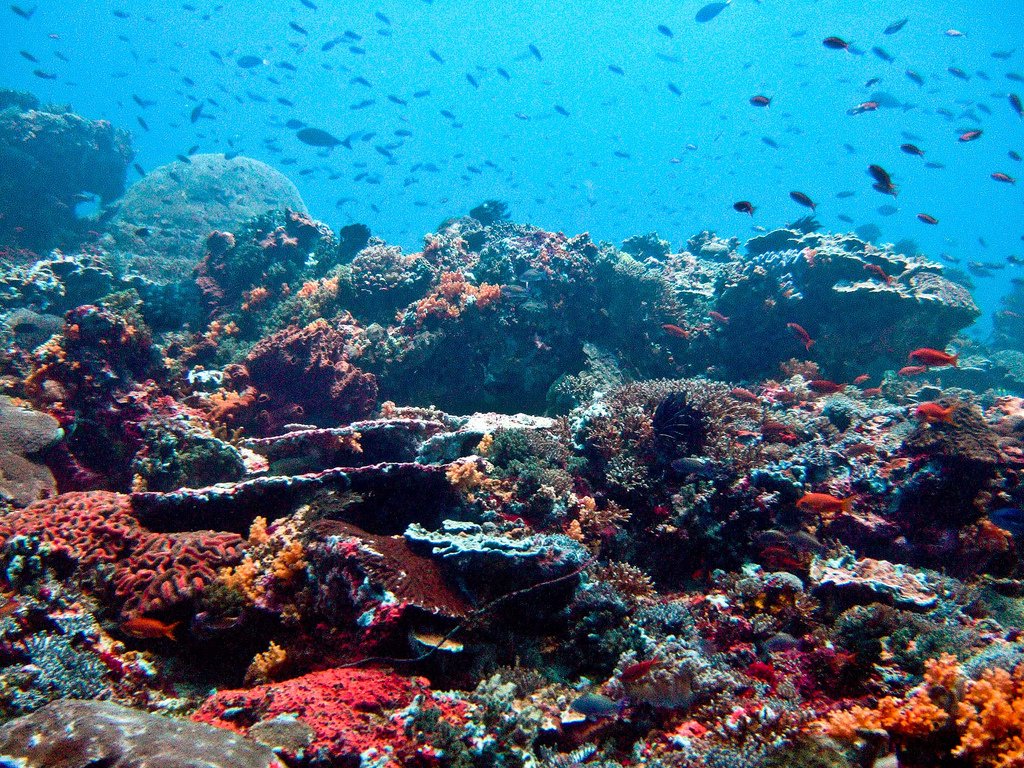Hey there, curious readers! Today, we’re diving deep into the mesmerizing world of coral reefs. Coral reefs are amazing – they’re like the busiest underwater cities full of colorful fish, corals, turtles and much more! Coral reefs are one of the most biologically diverse ecosystems on Earth. They are the largest living structure on the planet. Coral reefs existed for over 500 million years. They occupy less than 1% of the ocean floor, yet are home to over 25% of all marine species. Coral reefs are also known as “Rainforest of the Sea”. Have you ever wondered why do coral reefs have high biodiversity like this? Join us as we unravel this fascinating mystery!
What are Coral reefs and why do they exist?

- Coral reefs are colorful underwater cities built by tiny coral animals called polyps. At the base of a coral reef is a rock or sand foundation. On top of this, millions of tiny coral polyps construct limestone skeletons to form the actual reef structure.
- Coral polyps are tiny, soft-bodied animals That is related to hydroids, jellyfish, and sea anemones. They come in different shapes, sizes and colors – some look like antlers, others like brains or boulders! Coral polyps have a mouth surrounded by stinging tentacles, which they use to grab passing plankton to eat.
- Zooxanthellae are tiny single-celled algae that live inside the tissues of corals. They provide corals with – food through photosynthesis, contribute to the coral’s vibrant colors, and constant source of organic nutrition.
- In return, corals offer protection and nutrients to the zooxanthellae. This partnership allows corals to grow faster and build the reef structure.
- according to Coral Reef Alliance– Over 25% of all marine life can be found on coral reefs. As coral reef begins to grow, other animals and species are also attracted to the diverse habitat and find places to settle and call home.
- Coral reefs only grow in warm, clear, shallow tropical seas that let sunlight reach the coral and algae. The warm water also allows the coral animals to build their skeletons rapidly. Too much sediment or pollution can block sunlight and smother corals.
Why do coral reefs have high biodiversity?

Coral reefs have high biodiversity because of their endless nutrient cycling abilities, offer numerous nooks, crannies, and hiding places for a variety of marine life, and have symbiotic relationships with zooxanthellae which in return provide corals with food through photosynthesis. These factors make coral reefs a rich biodiversity hotspot. But exactly why do coral reefs have high biodiversity? why so jam-packed with life? Let’s find out in detail:
Lots of Hiding Spots and Hangouts

- One cool thing about coral reefs is that they aren’t flat and boring. The reef itself has tons of nooks, crannies, caves and structures that create little spaces for marine life to hang out and take shelter.
- Different corals come in all sorts of shapes and sizes – from branching corals that look like stag antlers to round boulder corals and big brain corals.
- These create the perfect hiding spots for little reef fish to duck into when predators come along. The holes and structures provide safe spaces for fish to rest, sleep and raise families. No need to fight over space when there are endless coral cavities to occupy!
- Corals aren’t the only things that make neat structures on the reef. Colorful sponges, soft tunicates and algae grow on the reef too, adding more layers. With so many options, reef creatures can be choosy about their favorite place to chill out!
An Underwater Buffet
- coral reefs offer an awesome all-you-can-eat buffet for the fish and sea creatures that live there! Firstly, the shallow sunlit waters mean plenty of sunlight for fast algae growth. This gives fish and other reef munchers endless snacks to graze on.
- Even the coral polyps themselves contain tiny algae called zooxanthellae that make food through photosynthesis like plants do. The zooxanthellae share this food with the coral, while the coral gives the algae a safe home – how nice! The corals also defecate nutrients that the other reef creatures gobble up. It’s a great recycling system.
- With so much algae to go around, plant-eating fish like parrotfish and surgeonfish can munch all day long. Meanwhile, crabs, shrimp, sea stars and sea cucumbers recycle leftover scraps, poop and decaying matter that sinks to the seafloor. No scrap goes to waste on the reef!
- Lastly, sharks, groupers and snappers hang out as the reef’s top predators. With tons of hiding spaces, smaller fish make perfect quick snacks for the big guys. The reef truly offers an all-inclusive feed for any appetite!
Nutrient Delivery System

- According to National Marine Sanctuary most reef-building corals have a unique partnership with tiny algae called zooxanthellae. The algae live within the coral polyps, using sunlight to make sugar for energy. This energy is transferred to the polyp, providing much-needed nourishment.
- As if all that reef-made food wasn’t enough, ocean currents also bring nutrients from the open ocean right to the coral reef’s door.
- Being close to land and islands means coral reefs are perfectly positioned to receive a constant stream of tasty nutrients.
- Ocean upwellings and tides bring nutrients to feed the hungry reef residents. It’s like living next to a 24/7 takeout shop!
A Year-Round Tropical Vacation
- Here’s another perk – coral reefs exist in warm tropical waters where temperatures stay nice year-round.
- In temperate areas with winter and summer, sea creatures have to become jacks of all trades to handle the changing temperatures and food availability. But not on coral reefs! Their stable conditions mean organisms can find a niche and stick to it.
- Parrotfish got the perfect jaws for scraping algae? They can scrape away! Butterflyfish evolved long noses for poking into coral nooks for food? Go for it! This specialization leads to more diversity, as species carve out unique roles. It’s like a never-ending summer vacation on the reef.
A Reef Patchwork

- Coral reefs aren’t all the same. Within a reef, you can find calm, sheltered lagoons, deep drop-offs, shallow sun-baked flats, and more! This patchwork of mini-habitats supports different types of life in each zone.
- Fringing reefs and atolls often have nearby seagrass meadows and mangrove forests, allowing animals like turtles to move between dining options.
- This smorgasbord of habitat variety means more niches to fill, which means more species can happily coexist! Variety really is the spice of life on the reef.
Safety in Numbers
- Coral reef biodiversity actually helps protect the reef system! Having loads of different organisms provides a safety net for the ecosystem as a whole.
- If one species’ population takes a nosedive, there are plenty of others that can pick up the slack.
- This flexibility makes coral reefs super resilient. They can bounce back after hurricanes, heat waves, diseases and human messes that knock down certain species.
Now you might have an idea- why do coral reefs have high biodiversity? Coral reefs are like bustling neighborhoods underwater! They have so many hiding spots, yummy food, and homes for different creatures. The species in coral reefs are all connected and depend on each other, making it a lively and vibrant place to be.
What makes coral reefs so special for us?
According to US Environmental Protection Agency (EPA)- Coral reefs are among the most biologically diverse and valuable ecosystems on Earth. An estimated 25 percent of all marine life, including over 4,000 species of fish, are dependent on coral reefs at some point in their life cycle. An estimated 1 billion people worldwide benefit from the many ecosystem services coral reefs provide including food, coastal protection, and income from tourism and fisheries.
Healthy coral reefs provide:
- Habitat, feeding, spawning, and nursery grounds for over 1 million aquatic species, including commercially harvested fish species.
- Food for people living near coral reefs, especially on small islands.
- Recreation and tourism opportunities, such as fishing, scuba diving, and snorkeling, which contribute billions of dollars to local economies.
- Protection of coastal infrastructure and prevention of loss of life from storms, tsunamis, floods, and erosion.
- Sources of new medicines that can be used to treat diseases and other health problems.
Threats to coral reefs biodiversity
- Climate change and ocean warming – Rising ocean temperatures cause coral bleaching events where corals expel their nutrient-providing algae. This can lead to widespread coral death. Ocean acidification due to increased CO2 also threatens coral growth.
- Destructive fishing practices – Methods like cyanide fishing and dynamite fishing directly damage coral structures. Overfishing key species disrupts the ecological balance.
- Pollution and sedimentation – Runoff from agriculture, sewage, and urban areas increases sediment and pollution that smothers corals and blocks sunlight.
- Tourism and recreation – Careless boating, anchoring, careless snorkeling, and diving can physically damage fragile corals. Poorly managed tourism leads to pollution.
- Nutrient enrichment and algal blooms – Excess nutrients from land-based runoff and upwellings fuel algal growth, which outcompetes and smothers corals.
- Coastal development and habitat destruction – Dredging, filling of wetlands, and destruction of mangroves for construction removes crucial nursery habitats.
- Unsustainable fishing and trade – Live fish, coral, and shell collection for food and aquarium trades deplete wild populations
According to Environmental Justice Foundation: More than 75% of all coral reefs on the planet are currently threatened by a combination of stressors including climate change, overfishing and destructive fishing, coastal development, pollution and damage.
According to EPA study: Most coral reefs occur in shallow water near shore. As a result, they are particularly vulnerable to the effects of human activities, both through direct exploitation of reef resources, and through indirect impacts from adjacent human activities on land and in the coastal zone. Many of the human activities that degrade coral reefs are inextricably woven into the social, cultural, and economic fabric of regional coastal communities.
Conclusion
In summary, Coral reefs are truly magical ecosystems, existing with life and wonder. They have crazy high biodiversity because of their cool colors, abundant food, warm water, different mini-habitats, and interconnected species. Understanding and protecting these fragile ecosystems is crucial for the well-being of our planet. So, let’s continue to explore, learn, and appreciate the beauty and importance of coral reefs for generations to come!
Remember lovely readers, our world is full of extraordinary marvels waiting to be discovered. Keep asking questions and seeking knowledge. Until next time, happy diving into the wonders of nature!
FAQs (Why do coral reefs have high biodiversity?)
Q1: Why are coral reefs called the “rainforests of the sea”?
A1: Coral reefs are often referred to as the “rainforests of the sea” due to their high biodiversity. Just like rainforests, coral reefs are home to an astonishing number of species, each playing a unique role in the ecosystem. They are both incredibly rich and diverse habitats.
Q2: How do coral reefs contribute to the overall health of our planet?
A2: Coral reefs provide various environmental benefits. They act as natural barriers, protecting coastlines from erosion and buffering the impact of storms. They also support local economies through tourism and fisheries. Additionally, coral reefs are carbon sinks, absorbing carbon dioxide from the atmosphere and helping mitigate climate change.
Q3: What is the most diverse coral reef in the world?
A3: The coral triangle in Southeast Asia, including Indonesia, the Philippines and Papua New Guinea, is the most biodiverse reef area. Some spots there have over 1300 fish species and 700 coral species in a single bay!
Q4: Why are coral reefs threatened?
A4: According to Environmental Justice Foundation: More than 75% of all coral reefs on the planet are currently threatened by a combination of stressors including climate change, overfishing and destructive fishing, coastal development, pollution and damage. and more. Already around 20% of the world’s reefs have been lost, and 35% more are at risk. Protecting what’s left is crucial!
Q5: How can we help coral reef biodiversity?
A5: Creating more marine protected areas, reducing carbon emissions, stopping overfishing, and cutting back pollution and careless tourism will all help coral reef biodiversity rebound. Regrowing corals in nurseries and rebuilding damaged reefs can also help.

